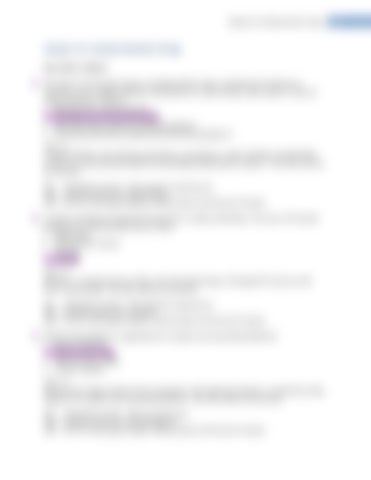Chapter 25: Antidysrhythmic Drugs
Chapter 25: Antidysrhythmic Drugs MULTIPLE CHOICE 1. The nurse is reviewing the classes of antidysrhythmic drugs. Amiodarone (Cordarone) is
classified on the Vaughan Williams classification as a class III drug, which means it works by which mechanism of action? a. Blocking slow calcium channels b. Prolonging action potential duration c. Blocking sodium channels and affecting phase 0 d. Decreasing spontaneous depolarization and affecting phase 4 ANS: B
Vaughan Williams class III drugs (amiodarone, dronedarone, sotalol, ibutilide, and dofetilide) increase the action potential duration by prolonging repolarization in phase 3. The other answers are incorrect. DIF: COGNITIVE LEVEL: Understanding (Comprehension) TOP: NURSING PROCESS: Implementation MSC: NCLEX: Physiological Integrity: Pharmacological and Parenteral Therapies 2. A patient is taking procainamide (Pronestyl) for a cardiac dysrhythmia. The nurse will monitor
the patient for which possible adverse effect? a. Bradycardia b. Shortened QT interval c. Dyspnea d. Diarrhea ANS: D
Diarrhea is a potential adverse effect of procainamide therapy. Prolonged QT interval on the ECG is also possible. The other options are incorrect. DIF: COGNITIVE LEVEL: Understanding (Comprehension) TOP: NURSING PROCESS: Evaluation MSC: NCLEX: Physiological Integrity: Pharmacological and Parenteral Therapies 3. Which nursing diagnosis is appropriate for a patient receiving antidysrhythmics? a. Risk for infection b. Deficient knowledge c. Deficient fluid volume d. Urinary retention ANS: B
Deficient knowledge related to lack of experience with medication therapy is a potential nursing diagnosis for a patient receiving antidysrhythmics. The other options are incorrect. DIF: COGNITIVE LEVEL: Applying (Application) TOP: NURSING PROCESS: Nursing Diagnosis MSC: NCLEX: Physiological Integrity: Pharmacological and Parenteral Therapies
131
